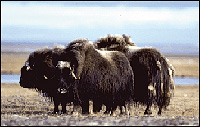



|
Muskoxen
Muskoxen meander across the Arctic Refuge coastal plain. This was not always so. They disappeared from Alaska's north slope more than 100 years ago. They were brought back to the Arctic National Wildlife Refuge in 1969. Today muskoxen have expanded to areas both west and east of the Refuge. As the only large mammals that live year-round on the Refuge coastal plain, muskoxen are uniquely adapted to a frigid environment. They have to be. Winter lasts nine months of the year, temperatures routinely drop to minus 20 degrees Fahrenheit or colder, and winds blow almost constantly. Yet muskoxen stay warm. How? Their long, skirt-like guard hairs and thick "qiviut" wool provide insulation, and their square, short-legged bodies retain heat. The animals also don't move around much in winter to conserve energy. In summer, muskoxen feed along rivers on a wide variety of plants. In winter they move to areas with low snow cover to feed on dried sedges and grasses. Adult females, young animals, and some males live in social groups year-round. Other males are solitary in summer and live together in winter. When threatened, muskoxen run together to form a circle or semi-circle with their sharp horns facing outward. This defensive technique is often effective against predators. The entire Arctic National Wildlife Refuge coastal plain supports muskoxen. In summer, they concentrate along major rivers including the Canning, Tamayariak, Sadlerochit, Jago, Aichilik, and Kongakut. Muskoxen are an important part of the Refuge ecosystem, adding to the area's diversity and providing a year-round food source for predators and other animals. The once vanished muskox brings a special majesty and aura to the Refuge. The Arctic National Wildlife Refuge protects habitats for this ice-age relic. It's one of the many reasons this special Refuge is important. Additional information is available from the references listed in the partial bibliography of scientific research pertaining to the Arctic National Wildlife Refuge. More general information on ANWR is available at: Arctic National Wildlife Refuge We would like to thank the Arctic National Wildlife Refuge for the above information. |
|



 Inupiat Eskimos call it "omingmak" or "the bearded one." Shaggy and social, with an almost surreal quality, the muskox, more than any other animal, conjures up images of the cold, remote arctic. Seeing one takes you back . . . to the time of the mammoth, the short-faced bear, and the saber-toothed cat.
Inupiat Eskimos call it "omingmak" or "the bearded one." Shaggy and social, with an almost surreal quality, the muskox, more than any other animal, conjures up images of the cold, remote arctic. Seeing one takes you back . . . to the time of the mammoth, the short-faced bear, and the saber-toothed cat.